April 30, 2023 – Volume 26, Issue 4
In This Issue
- Flanigan’s Net Positive: Climate and Human Rights
- The Brightline to Vegas
- Greening Green Ammonia
- 31 Countries Pass the EV Tipping Point
- GETs: Grid Enhancing Technologies
- Norway: Way Out Front with EVs
- Instant EV Rebates
- Finland’s Massive Thermal Energy Storage
- Flanigan’s Eco-Logic Podcast Updates
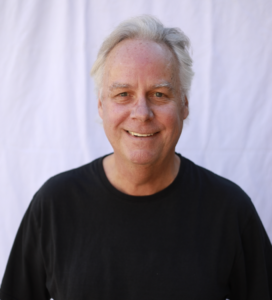
Flanigan’s Net Positive: Climate and Human Rights
It’s hard not to be struck by the global awareness of the severity of climate change, and the acknowledgement by so many countries and government bodies of the imperative at hand. Scientists have consistently warned of the unfolding calamity; now influential leaders like the unlikely yet fiercely determined young lady, Greta Thunberg from Sweden, and recently a group of senior Swiss women are making waves, thankfully amplifying the pace of change.
The case was brought by the Senior Women for Climate Protection – KlimaSeniorinnen – to the European Court of Human Rights in Strasbourg, France. The heat waves that have swept across Europe the past few years have been alarming. Research shows that older women are particularly susceptible to heat-related illnesses. KlimaSeniorinnen successfully claimed that Switzerland had failed to meet its climate protection targets. Switzerland had made a commitment to reduce its GHG emissions by 20% compared with 1990 levels, but the country has only achieved 11% of that target level.

In a landmark ruling, the European Court faulted Switzerland for violating human rights provisions. It’s the first time that an international court has determined that governments are legally obligated to meet their climate targets under human rights law. The Court affirmed that the climate crisis is a human rights crisis. The Swiss government was ordered to pay $87,000 to the group that brought the case to cover its costs and expenses.
The Director of the Center for Climate Change Law at Columbia University in New York expects to see, “a rash of lawsuits from other European countries, because most of them have done the same thing.” He notes that they too have failed to meet their climate goals and/or have failed to set adequate targets. We’re entering an age of climate accountability.
Quote of the Month
“We are the only industrialized country in the world that doesn’t have a high speed rail… and four years from now, we won’t be saying that anymore.”
The Brightline to Vegas
Los Angelenos are excited this week as construction has now officially begun on the Brightline, a high-speed rail line that will run from Los Angeles to Las Vegas. Service expected to commence in 2028. The rail line will run in the median of Interstate 15, a notoriously congested and dangerous stretch of highway. Las Vegas officials stated in the opening ceremonies that no longer will Vegas visitors be stuck in traffic for hours.
The Brightline project was launched on Earth Day. When complete, passengers will enjoy a two-hour ride at an average speed of 186 MPH. Secretary of Transportation Pete Buttigieg was on hand at the ceremony. He sees this as the beginning of the high-speed rail era in the United States: “Let’s go build that railroad.”
At first, the Brightline will not originate at Union Station in downtown Los Angeles. The new rail line will run from Rancho Cucamonga in the greater Los Angeles area, where it will connect with the regional Metrolink, to Las Vegas with stops in Hesperia and the Victor Valley. The Victor Valley station is planned to offer a future connection with the California High Speed Rail.
Experts have taken notice of the speed of the planning and development of the Brightline, which compares with the California High Speed Rail system that has been mired in political disputes, cost overruns, and permitting delays. The $12 billion Brightline project received a $3 billion grant from the Bipartisan Infrastructure Act. Thanks to its public-private partnership, the Brightline project will also be able to borrow $3.5 billion in tax exempt bonds.
The new rail line will span 218 miles, running at speeds up to 200 miles per hour. When complete, it will include 322 miles of overhead electrical lines to power the trains. No ticket prices have been announced, but Brightline has commented on average high speed rail costs being in the $0.50 – $1.00 per passenger mile. Amtraks’s service between New York and Wasington costs $1.25 per mile. At those rates, a round-trip ticket could cost ~$400.
Brightline is a proven business. It is already providing intercity service in Florida, connecting Fort Lauderdale, Miami, and Orlando. The Los Angeles to Las Vegas line will reduce CO2 emissions by 800 million pounds CO2e annually. It will provide 35,000 good-paying jobs during construction and many jobs when the line is operational. Brightline’s founder and chairman hopes that the new line will leave a positive legacy on the region, much like the Hoover Dam.
Greening Green Ammonia
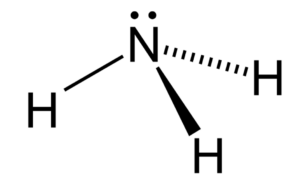
Ammonia – an inorganic chemical compound – made up one nitrogen atom bonded to three hydrogen atoms (NH3) – may not seem like an ideal fuel. The chemical – commonly used in household cleaners – smells foul and is toxic. It has also been used as a refrigerant (R717) and as an antimicrobial agent in food products.
But its primary use by far is as a fertilizer, some $60 billion worth annually that provides ~150 million metric tonnes of ammonia to farms worldwide. More than 50% of the world’s food production relies on ammonia fertilizer. Ammonia as a fertilizer has been and continues to be a powerful force in the Green Revolution. It is estimated that half of the nitrogen in the human body originated from a synthetic ammonia manufacturing facility.

Now ammonia is poised to become a major ingredient of the clean energy revolution. Ammonia’s energy density is twice that of liquid hydrogen by volume, and it is easier to ship and handle. So now a new application: Convert renewable energy into an energy-rich gas that can easily be cooled and squeezed into a liquid fuel. One expert noted that, “It’s a means of bottling wind and sunshine.” It can be shipped anywhere and later converted back into electricity or hydrogen gas to power fuel cell vehicles. With renewable energy, it’s an interesting piece of the carbon-free pathway.
Ammonia can be used as a fuel for combustion, with or without additives. Ammonia can be used directly in solid oxide fuel cells and direct ammonia fuel cells. Polymer electrolyte membrane fuel cells need reforming of the gas into nitrogen and hydrogen before hydrogen can be fed into the fuel chamber.
Green ammonia holds promise as part of the climate solution. It could help to power the world without carbon. But right now, ammonia production has a bad name in the climate world. Its production consumes 1% of the world’s energy and is responsible for 2% of greenhouse gasses globally. Most ammonia is synthesized using the Haber-Bosch method, a century old process that is fast, energy-intensive, and that emits vast amounts of carbon dioxide.
In 1909, Fritz Haber found a means of splitting N2 into nitrogen atoms, and then stripping hydrogen from fossil fuels, together bonding to form ammonia. It was commercialized by Carl Bosch. On the hydrogen side of the equation, Haber-Bosch involves a process in which steam reformation strips hydrogen from natural gas or coal. This is done using superheated steam (932 degrees F), and CO2 is left behind.
The second feedstock, nitrogen, is easily separated from the air which is 78% nitrogen. But melding the two gasses using the Haber-Bosch process”takes brute force” and requires up to 250 atmospheres of pressure. It was first used on an industrial scale in Germany during World War 1 following a blockage of nitrates from Chile. The ammonia was used to produce explosives to sustain war efforts.
Green ammonia can be made in a traditional, albeit inefficient method using electrolysis to split water to create hydrogen, and then running it through a Haber-Bosch high-pressure process to blend hydrogen and ammonia and make ammonia.
There is a promising, greener way of making ammonia called a “reverse fuel cell process.” While a fuel cell takes in natural gas, reforms its hydrogen and generates electricity and water, the reverse fuel cell uses nitrogen gas and water, zapped by electricity, to create ammonia. At present this new process’s yields are modest.
Imagine feeding nitrogen gas and water into a chamber. A power cord supplies electricity, splits the water molecule, and brings hydrogen and nitrogen together to form ammonia. The device exhales ammonia with no heat or pressure or carbon emissions. Breathing nitrogen in… and breathing out ammonia. Pretty idyllic, and in prototype phase only. Researchers are using different materials for electrolytes to try to speed and scale the promise. One expert cautions the age-old habits related to ammonia: “First, however, the evangelists for renewable ammonia will have to displace one of the modern world’s biggest, dirtiest, and most time-honored industrial processes: something called Haber-Bosch.”
31 Countries Pass the EV Tipping Point

Bloomberg NEF analysis shows that by the end of last year, 32 countries had reached and crossed the EV tipping point. It’s considered a pivotal level… when 5% of new sales are purely electric. “The threshold signals the start of mass adoption….” In 2022, only 19 countries had reached that level. Now, some of the fastest-growing markets for EVs in Eastern Europe and Southeast Asia.
More data: In the fourth quarter of last year, EVs accounted for 12% of global sales. The 32 countries that have crossed the tipping point represent two-thirds of global auto sales. There are eight countries with EV market share above 25%; three countries above 40%: Norway (79.6%), Iceland (58.4%), Denmark (44.9%).
There appears to be a “normal” pattern of EV adoption after the tipping point is reached. Typically, a country experiences marked acceleration after hitting the tipping point and engaging its virtuous cycle of more automakers, more choices, better and better charging capabilities, which all beget increased sales. Analysis shows that EV market share can surge from 5% to 20% in under four years.
Thailand hit 5% early in the year, and by year-end EV sales were 13% of the market. This rise coincided with the opening of Thailand’s first EV manufacturing plant, owned by China’s Great Wall Motor Company. In Turkey, Turkish auto company Togg introduced its battery-powered SUV, all-electric, that competes squarely with the Tesla Model Y. Turkey came over the tipping point and is now Europe’s fourth largest EV market.
Researchers note that this surge has not happened in the United States or South Korea for a variety of reasons, mostly due to range anxiety. The U.S. adoption rate is listed at 8.1% in the survey.
GETs: Grid Enhancing Technologies

One of the great challenges in ushering in widespread use of renewables is transmission capacity. We’ve got to get the wind and solar to the population centers. In many cases, this requires more transmission lines… or more accurately, more transmission capacity.
A New York Times article introduced many of us to GETs, Grid Enhancing Technologies. One of the most basic forms of GETs is upgrading transmission lines. In some cases, it’s possible to upgrade aging power lines. Replacing old cables with cables made of state-of-the-art materials can reportedly roughly double the capacity on the grid in many parts of the country. That means more transmission capacity for wind and solar.
“Advanced reconductoring” is widely used in other countries like Belgium and the Netherlands to bring more renewables to the grid, and less so in the United States. This is largely due to regulatory and bureaucratic hurdles according to researchers at the University of California at Berkeley, working with consulting firm GridLab. Most lines today consist of steel cores surrounded by strands of aluminum… a design that’s been around for a century. In the 2000s, companies developed cables using smaller lighter cores such as a carbon fiber that could hold more aluminum and that can carry up to twice as much current as older models.
Reconductoring – where it makes sense – can be done quickly. In 2011, American Electric Power in Texas urgently needed more power. The utility replaced 240 miles of wires on an existing transmission line with advanced conductors and increased the carrying capacity by 40%. The project took three years, far less than buying land and getting permits for a new transmission line. Building new lines has been called, “a brutal slog of permissions through a patchwork of different jurisdictions.”
There’s a GETs co-benefit too: In Montana the advanced conductors have been installed for wildfire mitigation. The new lines sag less in heat, making them less likely to contact trees. Both Montana and Virginia have legislation to support utilities’ investments in advanced conductors for safety.
Most appealing about reconductoring, and other forms of GETs, is that expanded capacity can open up new channels for renewables to get to market, many of which have been stymied by local grid conditions, too clogged to accommodate the capacity. A U.S. Department of Energy study found that the nation’s network of transmission lines may have to expand by two-thirds or more by 2035 to meet the nation’s renewable energy goals. The Princeton University REPEAT Project makes clear the need for getting renewables to market: Without sufficient transmission capacity, half of the emissions reductions expected from the Inflation Reduction Act may not materialize.
Grid Enhancing Technologies (GETs) is a term that was coined some years ago by staff at the Federal Energy Regulatory Commission. Currently, our grids are wasting wind and solar due to transmission shortfalls. Advanced power control technologies can reroute electricity in milliseconds to bypass congested circuits. GETs also make it possible to jam more power through an existing circuit: One GET involves sensors coupled with advanced controls that allow utilities to send more power without overloading lines. A system of “dynamic line rating” devices monitor transmission lines to figure out when the lines can handle more current. One company representative noted that today’s transmission systems are “woefully underutilized.”
Norway: Way Out Front with EVs

The latest monthly data shows that nearly 90% of all new car sales in Norway are fully electric vehicles. At this pace, battery electric vehicles will soon surpass petroleum-powered cars there.
Norway currently has 2.9 million registered vehicles. There are approximately 10,000 new vehicles sold in the country each month, of which battery electric EVs hold an 89.3% market share. If the sales trends continue, there will be more battery electric vehicles than petrol vehicles on the road by early 2025. The sale of pure-petrol cars is now negligible.
While Norway is getting lots of press for its rate of EV adoption, to be fair, the car fleet there is still dominated by diesel cars with 1,068,929 units. Diesel is followed by petroleum with 776,003 units; electric 700,358; and hybrid 339,724 – the latter being plug-ins with petrol engines.
The upside is that the climate protection of EVs is clear. The huge political support for electric vehicles in Norway has resulted in average new vehicle emissions of 15 grams/kilometer. That compares to the average emissions of a new vehicle in Australia of 164 kg/km… 11 times higher.
Instant EV Rebates
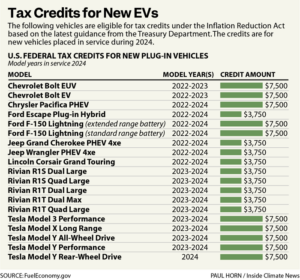
The United States Treasury has already disbursed nearly a half billion dollars in tax credits for EVs through the new Instant Rebate program which offers eligible customers up to $7,500 per clean energy vehicle. Most Americans qualified to buy an electric car can now claim their credit at the time of sale, straight from auto dealers. This up-front credit option is provided by the Inflation Reduction Act in 2022 and went into effect in 2024. The buyer gets the credit instantly; the IRS then pays the dealer back.
The U.S. Treasury reports that since January the Internal Revenue Service has processed almost 100,000 time-of-sale electric vehicle credit reports and has repaid dealers over $580 million in reimbursements. There are now 13,000 dealers which have registered on the IRS Energy Credits Online platform to enable these cash transactions. Rather than having to wait to get a tax credit, now EV buyers can deduct and instantly receive the credit amount at the dealership. Thus EV buyers pay a lower drive-away cost. In turn, the significantly reduced price of EVs is anticipated to further accelerate EV adoption.
The flip side of the tax credit equation is that the IRA tightened up on its eligibility requirements. There are now income caps of $150,000 and $300,000 for single taxpayers and those filing jointly. To receive a tax credit, the EVs need to be “constructed” in America, wiping out 70% of models that had previously been eligible, but strategically applying tax dollars domestically and realizing the economic multipliers of doing so.
Finland’s Massive Thermal Energy Storage
With 5.5 million people, Finland is the most northern and geographically remote European country. It is also the most densely forested country in Europe… and tops the list of the world’s happiest countries!
Given its cold winters, Finland’s heat consumption in summer is only one tenth that in winter. Thus the country has been a pioneer in seasonal energy storage… tapping waste and inexpensive energy from data centers, excess renewables, waste-to-energy, etc. – and storing it for winter use.
Per capita, the Republic of Finland is the largest producer of district heat in the Nordic countries. In 2023, 37.3 TWh of district heat was produced in the country. Of this 53% was from renewable heat sources and 14% from waste, the remainder from conventional fuels.
A couple of years ago, EcoNet News reported on a Finnish thermal energy storage system based on sand. Considered the world’s first sand-based system, Polar Night Energy’s system works by blowing at up to 1,100 degrees F hot air through pipes that heats sand in a massive steel container. The system is on site at a power plant near Kankaanpaa. The sand battery takes advantage of the lowest-cost power from the adjacent power plant, traps the heat, for later release. It also boosts the temperature of heat recovered from high-performance data servers. The sand battery has a capacity of 100 kW of heating power and 8 MWh.
Now another innovative Finnish seasonal storage project in Vantaa. Adjacent to Helsinki, Vantaa is Finland’s fourth largest city. Over 90% of its homes are connected and drawing heat from the central district heating loop. Vantaa has more than 373 miles of underground district heating network.
Vantaa Energy is jointly owned by the cities of Vantaa and Helsinki. Vantaa Energy now plans to build a massive, 90 GWh thermal energy storage facility. Called the Varanto project, which means “vault” or “reserve” in English, its underground caverns will be the volume of two Madison Square Gardens.
Planned to be completed in 2028, it will be the world’s largest seasonal energy storage system. Heat will be stored in three underground caverns almost a thousand feet long and 66 feet wide by 132 feet high. The caverns will hold a volume of 290 million gallons of hot water. The water will be pressurized to prevent boiling and evaporation at temperatures up to 280 F.
Two, 60 MW electric boilers will produce heat from excess renewable energy, at times when it is abundant and cheap. Heat will be stored and injected into the district heating system when needed. With all permits in place, Varanto is set to break ground this summer. Its cost will be ~$217 million.
Flanigan’s Ego-Logic Podcast Updates
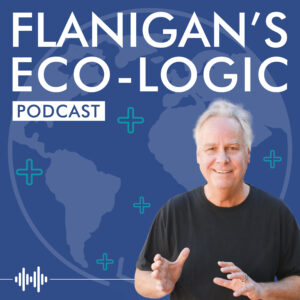
Use the links below to check out our recent podcasts. And you can always go to Spotify and type in “Ted Flanigan” to find our library of podcasts.
Recently Released:

EcoNet News, Volume 25, Issue #4, acknowledges the global awareness of the severity of climate change, and its connection to human rights. Ted highlights the landmark ruling by the European Court, which faulted Switzerland for violating human rights provisions, and affirmed that the climate crisis is a human rights crisis. He goes on to share the exciting news of the Earth Day launch of construction of the Brightline, a high-speed rail line that will run from Los Angeles to Las Vegas!
He also highlights green ammonia becoming a major ingredient of the clean energy revolution, 31 countries passing the EV tipping point, GETs or Grid Enhancing Technologies, 90% of all new car sales in Norway being fully electric vehicles, instant EV rebates in the US, and Finland’s massive thermal energy storage.
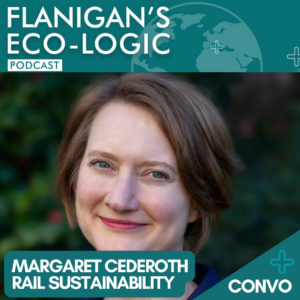
In this episode of Flanigan’s Eco-Logic, Ted speaks with Margaret Cederoth, Director of Planning and Sustainability at California High-Speed Rail Authority. She is an urban planner with more than two decades of global sustainable infrastructure delivery, rail system planning, design, and construction, and land use/ transportation planning experience. Margaret’s expertise is with complex transportation infrastructure projects, as well as international urban development throughout North Africa and the Middle East.
She was appointed by Governor Newsom in 2019 to be the Director of Planning and Sustainability at California High-Speed Rail. Her duties include policy development and implementation, station and station area planning, greenhouse gas emissions inventory, tracking, and offsets, renewable energy planning, sustainable design, and district-scale sustainability approaches.

In this episode of Flanigan’s Eco-Logic, Ted speaks with Captain Liz Clark, surfer, sailor, environmentalist and author of Swell, a memoir published by Patagonia, chronicling her voyage sailing 20,000 nautical miles of ocean. The book shares tales of sailing in high seas, of solitude and surprises, but also of hardship and difficulties she faced both within herself and in the outside world, ultimately finding a connection to the earth and commitment to living in harmony with it.
At fifteen, her love of the ocean and natural athletic inclination led her to try surfing, and eventually started competing, surfing in private contests and for the UCSB surf team while studying at UC Santa Barbara. Liz enjoyed the exploratory part of surfing, looking for remote waves, and has since spent the last nine years exploring the Pacific, searching for and surfing numerous incredible reef passes as well as working on local environmental projects and presenting talks in schools across Polynesia to raise awareness of pollution and conservation issues. Her aim is not only to promote environmental awareness in the places that she visits, but also to do so on a larger scale by documenting her voyage and sharing it through her writing and photography in the hope that it will inspire others to live out their passions and connect with both themselves and the planet.
Liz is now based in French Polynesia, where she started writing Swell, and has dropped the hook more permanently in Tahiti with her partner to expand her activism work, resulting in the creation of A Ti’a Matairea, a non-profit organization in French Polynesia working for environmental protection, animal welfare, and youth empowerment. There is more sailing in her future, but for now, she is enjoying giving back to the planet and learning how to positively impact local environmental issues.

In this episode of Flanigan’s Eco-Logic, Ted speaks with Jacquelyn Francis, Founder and Executive Director of the Global Warming Mitigation Project (GWMP). GWMP contributes to decarbonizing the planet by identifying innovative climate leaders and deploying resources to advance solutions. It comprises three interconnected programs that work together to address the funding, capacity building, and visibility challenges that global changemakers face as they scale their science-based solutions to decarbonize the planet: The Keeling Curve Prize, The Constellations Fellowship, and The Climate Impact Conduit.
GWMP’s signature program is the Keeling Curve Prize, which awards $50,000 annually to each of 10 global projects that demonstrate the ability to reduce, replace, or remove greenhouse gases in the atmosphere. Since 2018, GWMP has awarded $1.75M to 60 nonprofits, for-profits, and startups, vetted more than 1,100 viable solutions, and grown one of the largest networks of global warming mitigators in the world. The projects that GWMP has awarded are currently projected to reduce 3.27 gigatons of CO2e emissions this year alone.
She shares some of her favorite impact stories with Ted, highlighting creativity from the younger generation finding new ways to make solutions that are smart and effective. She also discusses upcoming events, running programs, and a new tool within their database – carbon abatement portfolios – an idea that comes from the voluntary carbon markets. She concludes by emphasizing that solutions to the energy transition and emission abatement already exist, and are just waiting to be scaled up.
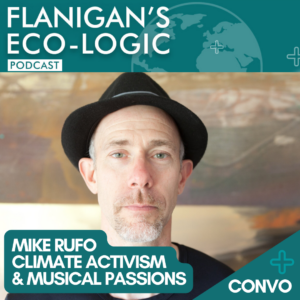
In this episode of Flanigan’s Eco-Logic, Ted speaks with Mike Rufo, Musician and Energy / Climate Policy Consultant and Activist. Mike has had a long and distinguished career working with energy efficiency and modelling, as well as resource planning and cost effectiveness evaluations. He is now semi-retired, focusing on his career in singing-songwriting, with three albums since 2012 and another recently released.
Ted and Mike dive into his pivot from 30 years in virtually all aspects of energy resource consulting and management, to music and activism. Music, for him, became a vessel to be environmentally active. He shares that he is a Board Member of Music Declares (Climate) Emergency-US, which comprises a group of artists, music industry professionals and organizations that stand together to declare a climate and ecological emergency, and call for an immediate governmental response to reverse climate change. They believe in the power of music to promote the cultural change needed to create a better future.
Mike recorded his first album in 2012, and recently released his new album, “living is,” debuting a single from the album, “The Reckoning” which is his ode to Earth, live on the podcast for Earth Day!

In this episode of Flanigan’s Eco-Logic, Ted speaks with Jesse Moore, CEO and Co-Founder at M-KOPA, the world leader of affordable “pay-as-you-go” financial services for low-income customers based in Africa. Since commercial launch in 2012, M-KOPA has connected, provided, and served over 3 million customers to affordable off-grid distributed solar systems and connectivity solutions, including lighting, charging, radio, TVs, fridges, and smartphones.
M-KOPA was founded with an idea of combining the power of digital micropayments with GSM connectivity to make life-enhancing assets more accessible. Jesse has since overseen the company’s growth from startup to over 2,000 employees and 20,000 sales agents. M-KOPA currently has offices in Kenya, Uganda, Tanzania, Nigeria, Ghana, UK and Hong Kong. The company has received numerous awards for its innovation, impact and scale: including winning the prestigious Zayed Future Energy Prize, making the coveted MIT Technology Review 50 Smartest Companies list, and being listed by Fortune Magazine as one of the Top 50 Companies Changing the World. Investors in M-KOPA include Generation Investment Management, CDC Group and Standard Bank, as well as esteemed entrepreneurs such as Virgin Founder Sir Richard Branson and AOL founder Steve Case.
As a leader in empowering homes and small businesses through connected technology, Jesse is representative of an industry of entrepreneurs that sees the only way to address these fundamental problems within commercial markets at scale is with companies that are responsive to customer needs instead of donor biases, and are able to innovate, drive prices down, and continuously provide products that people need.
